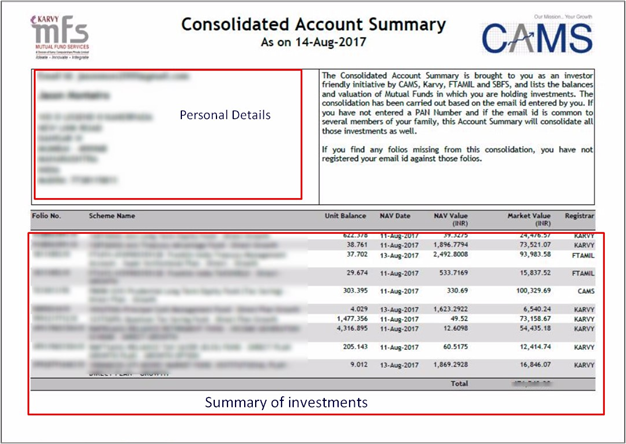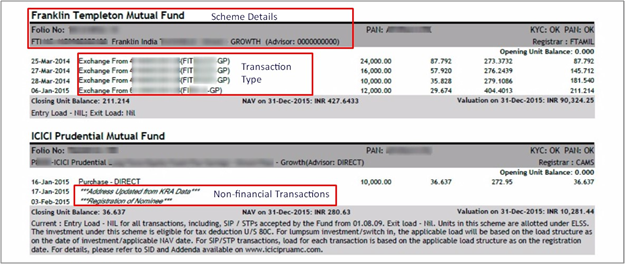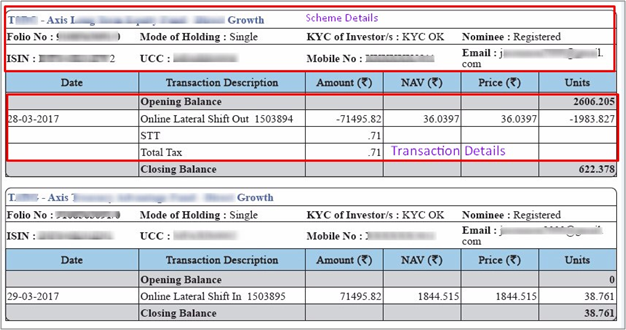Those of you who have experienced how stock markets work would be accustomed to market swings. Yet, the market has the tendency to surprise even the most experienced traders and investors. Equity markets can undergo bouts of strong trends in either direction or even remain directionless for days and even months.
Certainly, the market swings might have worried many of you. At such times, most investors are eager to know how their mutual fund investments have performed. Whether the performance drifted with the market tide or went against it.
Many investors may not be very tech-savvy to use online portfolio tracking services and some may avoid using them due to privacy issues. For them, requesting for a mutual fund statement is the easiest way to keep a track of their investments. One can request a statement for specific mutual fund accounts from the fund house directly or even request for a Consolidated Account Statement (CAS) from the registrar or a Depository. The CAS gives a holistic view of all your holdings.
Yes, you can request for an account statement at any time and it will be delivered to your e-mail inbox in a few hours. There are different routes through which you can request a CAS. Depending on your type of holding, you can request for a statement as mentioned below.
→ Physical or Non-Demat holding
If you hold Mutual Fund Units in physical form, which are represented by a Statement of Account (SoA), you can request for a CAS as below.
Computer Age Management Services (CAMS) - Consolidated Account Statement - CAMS + Karvy + FTAMIL + SBFS
Karvy Computershare – Consolidated Account Statement
Mutual Funds held specifically in SoA form and linked by a common email address will be consolidated. Ensure that your correct email id is registered with the respective mutual fund folios. You have the option to request for a summary statement or a detailed transaction statement for a defined period. If you require the statement only of a specific fund house, you can send a request to the fund house directly.
→ Partial or Fully Demat Holding
If a part or entire of your mutual holdings is in demat form, you can request for a CAS from the Central Depository Services Limited (CDSL) or National Securities Depository Limited (NSDL). Through this CAS, holdings in demat account(s) held with NSDL and CDSL as well as in units of Mutual Funds held in the Statement of Account (SOA) form will be consolidated. If you have made any transactions, the depository will send the monthly statement to your email address in the following month. You can also request for a statement by accessing the links below:
CDSL - https://www.cdslindia.com/cas/logincas.aspx
NSDL - https://nsdlcas.nsdl.com/
Here, the accounts that reflect a common Permanent Account Number (PAN) are consolidated.
Both statements will give you a summary of your holdings and details of transactions, if any. If you are investing in stocks as well, the CAS from either depository will give you a wider picture of your holdings.
Now that you know how to access the CAS for mutual fund investments, let’s delve deeper into how to read the statements.
CAS received from CAMS/Karvy
A summary statement is straightforward. Along with the personal details at the beginning, the statement provides a list of your current holdings. You will get the unit balance and the latest market value of your investments.

(Source: CAMS Consolidated Statement, PersonalFN Research)
The transaction statement is a bit more detailed. It will summarise all purchase or redemptions made in a specified period. Whether you have made one-time purchases or if you are
investing via a Systematic Investment Plan (SIP), it will reflect here. Along with the cost of purchase, it provides the current market value, using which you can calculate the performance of your investment/s.

(Source: CAMS Consolidated Statement, PersonalFN Research)
Apart from financial transactions, this statement also keeps a record of all non-financial updates on your account as well. In case you have changed bank details, updated a nominee, or corrected your address, such revisions will be updated in this statement.
Apart from this, any change in load criteria is mentioned under the transaction summary for every scheme. Beside the scheme name, the ARN code of the distributor is also mentioned. This can be helpful when you may have purchased funds through multiple distributors or an advisor.
Pay special attention to the below parameters in the statement -
- Folio number – It is a unique number that has been assigned to your investments made with the mutual fund house. Most mutual funds offer one folio number for all investments. Thus, if you intend to make further investments with the same fund house, ideally you should mention the folio number allotted to you earlier.
- Fund name and option – It is vital to check whether your account statement correctly mentions the mutual fund scheme (along with the option – i.e. dividend or growth ) you opted for. This is essential because your mutual fund account statement may reveal a different mutual fund scheme or an option. In case if you find any discrepancies, you need to bring it to notice of your mutual fund distributor / agent / relationship manager, or even write to the mutual fund house for a corrective course of action.
- Transaction summary – This section of your mutual fund account statement reveals the transactions that have been done with the fund house. So say, in case you have opted for SIP mode of investing or a Systematic Withdrawal Plan (SWP) for redemptions;; your future account statements would reveal these transactions (date wise), along with the other details such as NAV and number of units. Similarly, if you have opted for the dividend payout or reinvestment option (instead of growth), it would reveal the value of the dividend declared along with how they have been.
- Current cost and market value –The current cost refers to the investment amount, which enables you to obtain “xx” number of units at an “xx” value of NAV The market value mentioned in your mutual fund account statement helps in assessing the value of your investments as the date on which the mutual fund statement is generated. So, it will reveal whether from the date of investment to the date the statement of account wealth creation or wealth erosion has occurred.
CAS received from CDSL/NSDL

(Source: CDSL Consolidated Statement, PersonalFN Research)
In this eCAS from CDSL or NSDL, you will get a summary as well as a detailed view of your holdings. The summary page will list all your holdings across stocks and mutual funds. Here you will be able to view the latest value of your holdings. In addition to the current valuation, the summary statement mentions the ‘Cumulative Amount Invested’. This includes the sum of all one-time and regular investments via a
Systematic Investment Plan (SIP), net of any redemption.
Further, you will get details of any transactions made over the period.

(Source: CDSL Consolidated Statement, PersonalFN Research)
While the transaction statement looks different from that received from CAMS or Karvy, it provides the same set of information. The exit load details for all schemes are mentioned at the end of the transaction report.
Remember, it is your hard-earned money, which means you need to ensure that the mutual fund account statement and scheme details are accurate, thereby safeguarding yourself with information.
If there is any discrepancy, do not hesitate to
contact your financial advisor or mutual fund distributor. If you have invested directly, you can contact the customer service helpline of respective fund house.
If you are unhappy with the way your funds are performing, we suggest you approach
PersonalFN’s ethical and unbiased investment advisers to have your mutual fund portfolio reviewed.
Here you will get Buy / Sell / Hold recommendations on your existing portfolio. In addition, a fresh portfolio will be constructed based on your requirement and risk profile. We highly recommend that you opt in for it.
Add Comments
| Comments |
abprajapati.1feb@gmail.com
Apr 03, 2019
please send my mail ID Consolidated statement of mutual funds FROM 31.07.2018 TO 31.03.2019 |
AMIT198449@YAHOO.COM
Apr 07, 2019
CONSOLIDATED ACCOUNT STATEMENT |
jssopnar711@gmail.com
Apr 20, 2018
consolideted statement of mutual funds up to 31 march 2018 |
hpsidc79@gmail.com
Apr 24, 2018
Consolidated mutual funds statement for march2018 |
vjohnsebastian@gmail.com
Apr 26, 2018
I would like to get my latest NSDL statement |
1 ...